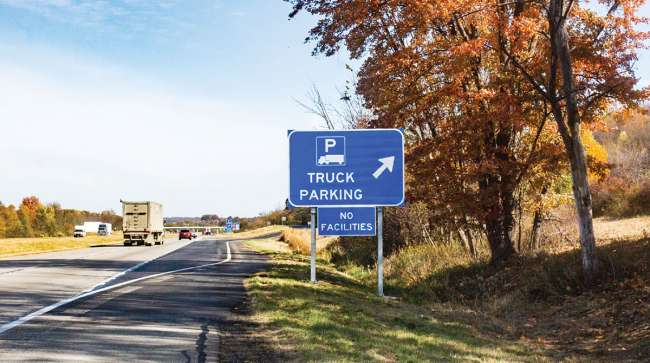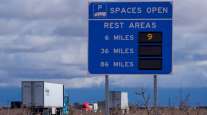Staff Reporter
Stakeholders Dissect Truck Parking Challenges

[Stay on top of transportation news: Get TTNews in your inbox.]
Freight stakeholders have many ideas for how to address the trucking industry’s shortage of safe truck parking, but all agree it’s not an easy challenge.
“It’s one of these true public policy problems, because you have a lot of different stakeholders but no real market solution,” said Nicole Katsikides, research scientist at the Texas A&M Transportation Institute. “You see this perfect storm of issues related to parking. But what we know is the population is growing, demand is growing, trucking is growing.”
The American Transportation Research Institute has long been working to identify strategies for increasing both public sector and rest stop parking, including developing best practices for freight planning that states can use. It has also developed real-time truck parking information systems so drivers can locate available spots. But ATRI senior vice president Daniel Murray warned that more ideas are needed.
“We’ve done everything we can,” he said. “Literally Band-Aid after Band-Aid in terms of helping the truck driver. But we’re now at sort of the apex of if we don’t expand capacity, public and private, we’re just going to spin our wheels. And so, I think we have some huge opportunities in Washington, D.C.”

Katsikides
In Congress, the House of Representatives is considering a bill, HR 2367, that would direct $755 million to addressing truck parking. The U.S. Department of Transportation issues grants to state agencies as well. Murray notes, however, that these DOT funds can be sporadic, and stressed the need for a dedicated funding program that prevents localities from having to choose between parking and other issues.
“They shouldn’t have to be painted into a corner where they’re told pick one — roads, bridges or truck parking,” Murray said. “I’m hopeful that we start to focus on capacity increases. As you know, truck parking is the No. 1 issue for truck drivers three years in a row in our ATRI top industry issues report.”

Ward
Truckload Carriers Association President Jim Ward is hopeful that lawmakers will remain focused on the issue. “There’s been a bill passed out of the House and now there’s one being discussed in the Senate,” he said. “We know there’s some big issues that need to be addressed whenever they come back in session, especially from a budget perspective. But we’re really hoping that this time we have a real opportunity to be able to get this to the finish line.”
Ward noted the problem continues to grow as state and local governments experience warehousing growth without adequate thought given to accommodating parking.
Katsikides further noted that there are different types of parking needs, such as short- versus long-term, and different requirements in terms of staging equipment. She noted another problem is that people don’t want truck parking in their communities, despite localities often worsening the problem through economic development plans. For its part, the Texas A&M Transportation Institute has undertaken efforts to increase awareness of the issue while also providing truck parking information to state agencies. That includes using data to pinpoint hot spots for parking demand.
“Truck parking [has been] growing in awareness as a problem,” she said. “You started to see people start dissecting [the issue] and finding it’s not easy to solve because it’s very multifaceted. It’s not a one-size-fits-all problem.”
Ward stressed that a “multifaceted approach” is needed, which relies on available information. “There is data available,” he said. “You can see these chokepoints where Texas A&M, through heat maps, can certainly take a look at where are we having this overflow and where are these trucks having to go to park.”
The Minnesota Department of Transportation views truck parking as a necessary working condition for driver safety and fairness, but has had to balance that against local interests that have resisted the issue. The cities of Minneapolis and St. Paul have banned truck parking in certain areas.
Want more news? Listen to today's daily briefing above or go here for more info
“There is both a national and statewide shortage of truck parking,” said Andrew Andrusko, freight and railroad planning section interim supervisor at MNDOT. “We know that on average truck parking shortages cost a truck driver $5,500 a year. It often takes a truck driver 45 minutes or more to find truck parking, particularly in the evening hours. But truck parking has a human cost. It’s a human need, rest is a human need.”
MNDOT found in a study there were only 4,834 truck parking spaces available across the state in 2019, but there were over 26,000 daily truck trips. Andrusko noted that the most acute need rises in localities that are cutting down on parking capacity.
“Truck parking is increasingly becoming a concern for urban cities in terms of managing the need for truck parking occurring in areas where it is being seen as a nuisance, as an environmental risk factor for vulnerable populations, as well as an issue in which there’s a perception of negative or pejorative connotations for truck drivers,” Andrusko said.




